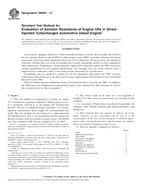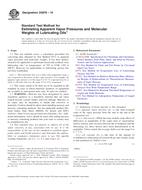Potrebujeme váš súhlas na využitie jednotlivých dát, aby sa vám okrem iného mohli ukazovať informácie týkajúce sa vašich záujmov. Súhlas udelíte kliknutím na tlačidlo „OK“.
ASTM D6894-13
Standard Test Method for Evaluation of Aeration Resistance of Engine Oils in Direct-Injected Turbocharged Automotive Diesel Engine (Withdrawn 2022)
Automaticky preložený názov:
Štandardná skúšobná metóda na vyhodnotenie prevzdušňovanie odporu olejov motora v Priamy nástrek preplňovaný vznetový motor Automotive
NORMA vydaná dňa 1.5.2013
Informácie o norme:
Označenie normy: ASTM D6894-13
Poznámka: NEPLATNÁ
Dátum vydania normy: 1.5.2013
Kód tovaru: NS-36917
Počet strán: 12
Približná hmotnosť: 36 g (0.08 libier)
Krajina: Americká technická norma
Kategória: Technické normy ASTM
Kategórie - podobné normy:
Anotácia textu normy ASTM D6894-13 :
Keywords:
aeration, automotive, diesel engine, EOAT, foaming, heavy-duty, HEUI, medium-duty, ICS Number Code 75.100 (Lubricants, industrial oils and related products)
Doplňujúce informácie
| Significance and Use | ||||||||||||||||||||||||||||||||||||||||||||||||||||||||||||||||||||||||||||||||||||||||||
|
5.1 Background—In the HEUI fuel system, the engine oil from the oil sump not only lubricates the engine, it also supplies a high-pressure oil system that takes oil from the main gallery and pressurizes it up to 20.7 MPa in a plunger pump (see 5.1.1 Prior to 1994, the ability of an engine lubricant to resist aeration was measured by Test Method D892. During the development of the API CG-4 category in 1994, however, it was found5.2 Method—The data obtained from the use of this test method provide a comparative index of the aeration resistance of engine oils used in medium- and heavy-duty truck diesel engines. 5.3 Use—The tendency of engine oils to aerate in direct-injection, turbocharged diesel engines is influenced by a variety of factors, including engine oil formulation variables, oil temperature, sump design and capacity, residence time of the oil in the sump, and the design of the pressurized oil systems. In some engine-oil-activated injection systems, the residence time of the oil in the sump is insufficient to allow dissipation of aeration from the oil. As a consequence, aerated oil can be circulated to the injector intensifiers, adversely affecting the injection timing characteristics and engine operation. |
||||||||||||||||||||||||||||||||||||||||||||||||||||||||||||||||||||||||||||||||||||||||||
| 1. Scope | ||||||||||||||||||||||||||||||||||||||||||||||||||||||||||||||||||||||||||||||||||||||||||
|
1.1 This test method was designed to evaluate an engine oil's resistance to aeration in automotive diesel engine service. It is commonly referred to as the Engine Oil Aeration Test (EOAT). The test is conducted using a specified 7.3 L, direct-injection, turbocharged diesel engine on a dynamometer test stand. This test method was developed as a replacement for Test Method D892 after it was determined that this bench test did not correlate with oil aeration in actual service. The EOAT was first included in API Service Category CG-4 in 1995. 1.2 The values stated in SI units
are to be regarded as standard. No other units of measurement are
included in this standard.
1.2.1 Exception—Where there is no direct SI equivalent, for example, screw threads, national pipe threads/diameters, and tubing size. 1.3 This standard does not purport to address all of the safety concerns, if any, associated with its use. It is the responsibility of the user of this standard to establish appropriate safety and health practices and determine the applicability of regulatory limitations prior to use. 1.4 This test method is arranged as follows:
|
Podobné normy:
Historická
1.10.2011
Historická
15.4.2012
Historická
1.5.2014
Historická
15.4.2009
Historická
1.10.2010
Historická
1.10.2010



 ASTM D2711-11
ASTM D2711-11 ASTM D2715-92(2012)..
ASTM D2715-92(2012).. ASTM D2782-02(2014)..
ASTM D2782-02(2014).. ASTM D2783-03(2009)e..
ASTM D2783-03(2009)e.. ASTM D2878-10
ASTM D2878-10 ASTM D2879-10
ASTM D2879-10
 Cookies
Cookies
